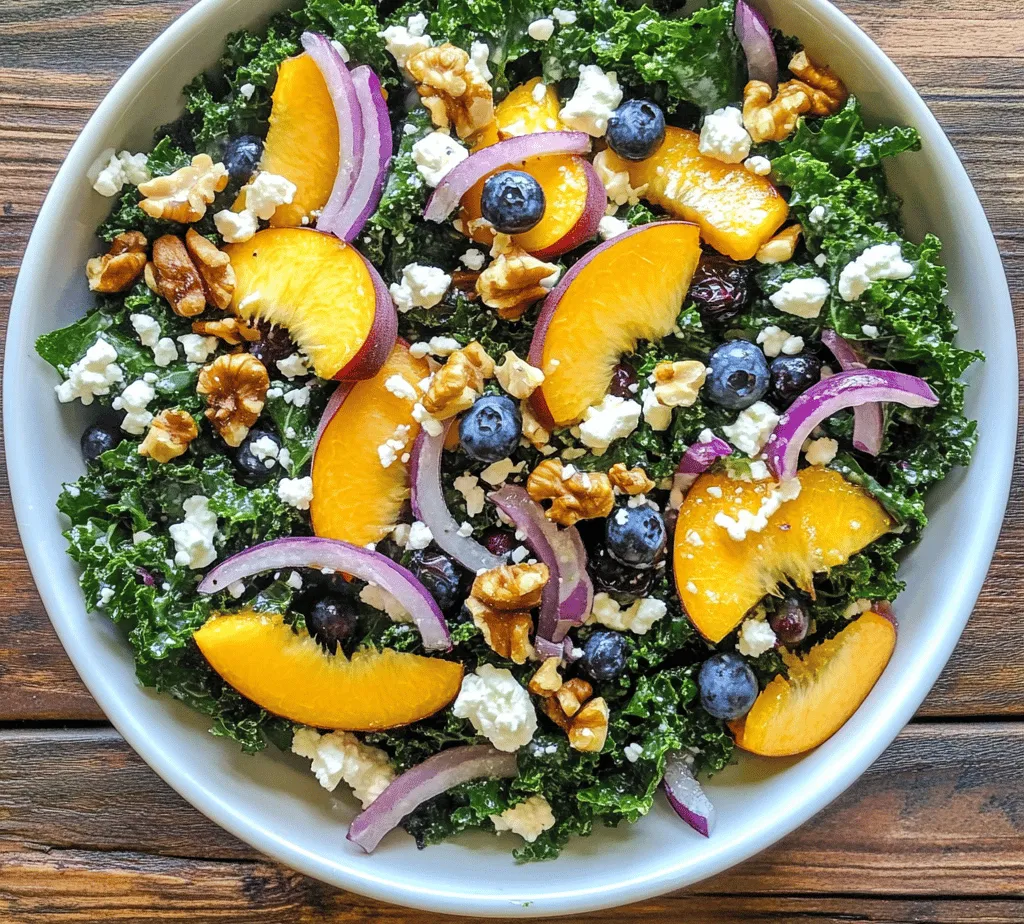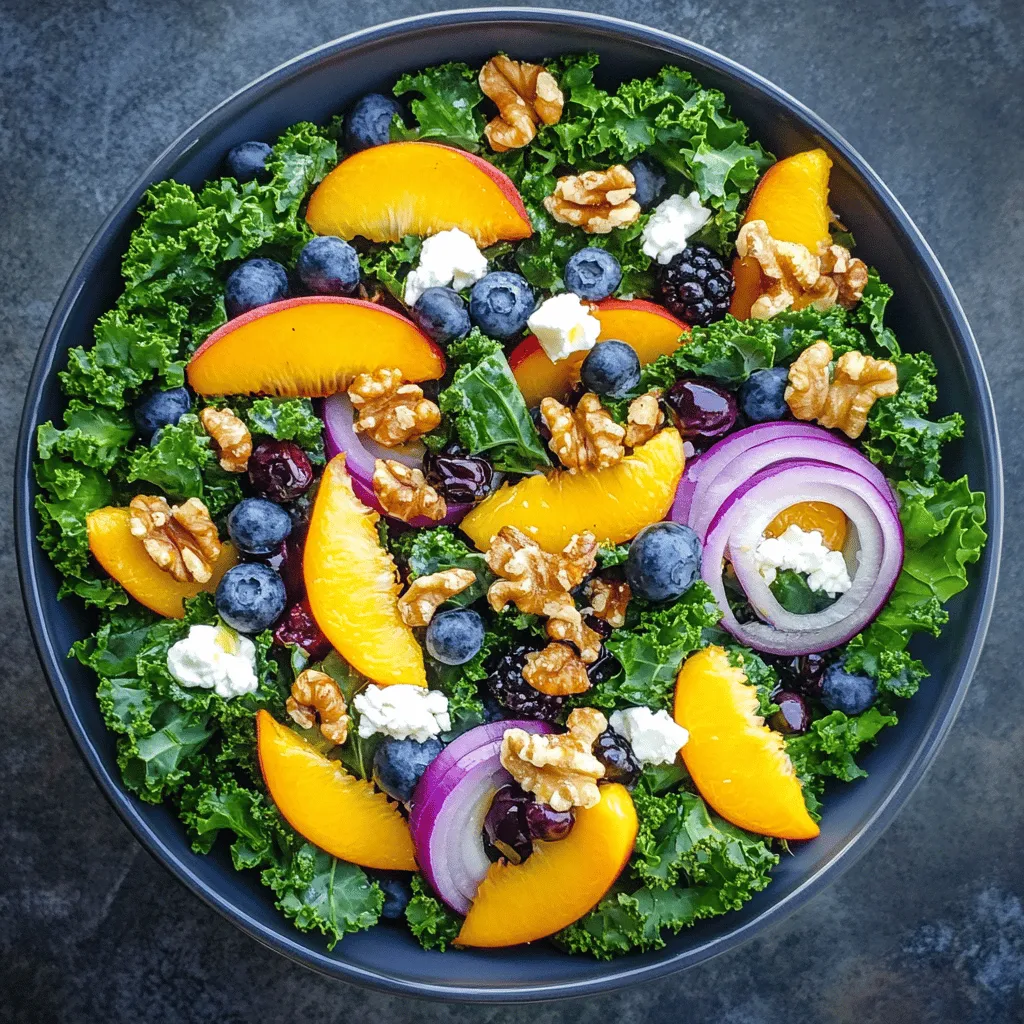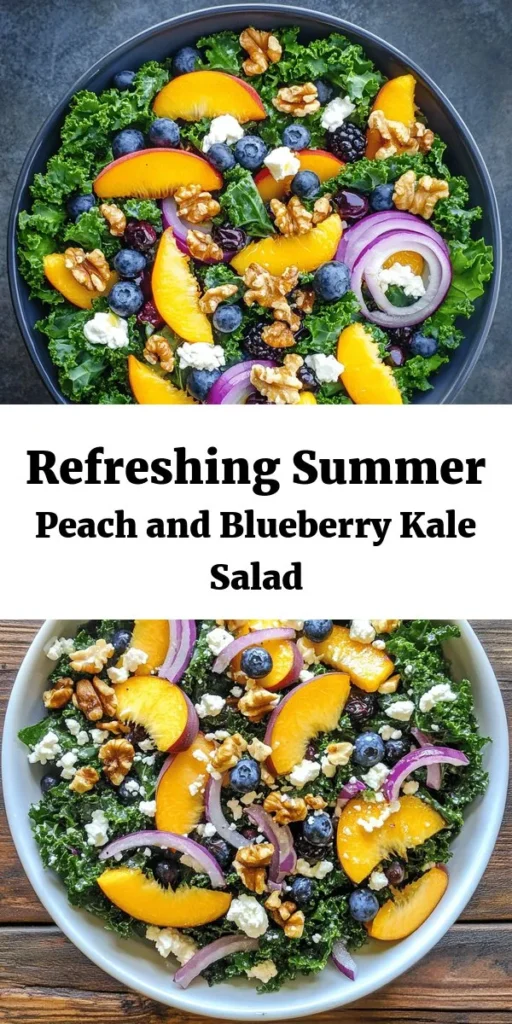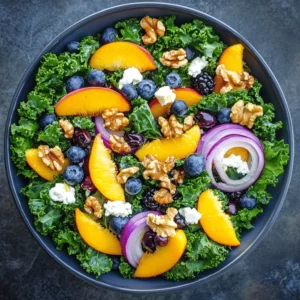Introduction
As the temperature rises and the days stretch longer, the allure of summer brings with it a craving for fresh, vibrant dishes that embody the essence of the season. Summer salads, in particular, shine during these warm months, offering a delightful combination of flavors, colors, and textures that can be both nourishing and satisfying. Among the myriad of summer salad options, the Summer Peach and Blueberry Kale Salad stands out as a particularly refreshing choice. This salad is not just a feast for the eyes; it also packs a punch in terms of nutrition, making it a perfect addition to your summer dining repertoire.
This vibrant dish marries the sweetness of ripe peaches and juicy blueberries with the hearty, nutrient-dense leaves of kale. The result is a colorful, nutrient-rich salad that is as delicious as it is beautiful. Not only does it serve as a satisfying meal on its own, but it also makes an excellent side dish for summer barbecues and gatherings. With its combination of flavors and textures, this salad is sure to impress your family and friends.
Beyond its aesthetic appeal, the health benefits of the key ingredients in this salad are truly remarkable. Kale, often regarded as a superfood, is loaded with vitamins, minerals, and antioxidants that contribute to overall health. Peaches and blueberries, both summer staples, bring a naturally sweet flavor while offering a variety of vitamins and phytonutrients. The addition of walnuts adds a satisfying crunch and healthy fats, making this salad not only delicious but also balanced and nutritious.
In this article, we will delve into the details of creating this Summer Peach and Blueberry Kale Salad, exploring each ingredient’s nutritional profile and preparing the salad step by step. Whether you’re looking for a light lunch, a side for dinner, or a dish to bring to a summer gathering, this salad will be your go-to recipe. Let’s first take a closer look at the key ingredients that make this salad shine.
Understanding the Ingredients
Kale: The Nutritional Powerhouse
Kale has earned its reputation as a nutritional powerhouse, and for good reason. This leafy green is rich in essential vitamins and minerals, including vitamin K, vitamin A, vitamin C, and several B vitamins. Additionally, kale is loaded with antioxidants such as quercetin and kaempferol, which help combat oxidative stress and inflammation in the body. The high fiber content of kale also supports digestive health, making it an excellent choice for those looking to maintain a healthy diet.
When selecting kale, look for vibrant, deep green leaves that are crisp and free from blemishes. Avoid any bunches that display yellowing or wilting, as these are indicators of age. For storage, wrap the kale in a damp paper towel and place it in a perforated plastic bag in the refrigerator. This will help keep the leaves fresh for up to a week.
Peaches: Sweetness of Summer
One bite of a ripe peach can transport you to a sun-drenched orchard, and their sweetness is a hallmark of summer. Peaches are not only delicious but also packed with nutrients. They are a good source of vitamins A and C, potassium, and dietary fiber. Their high water content makes them hydrating, and the natural sugars provide a quick energy boost.
When it comes to salads, choose peaches that are firm but slightly soft to the touch, indicating ripeness. Varieties such as Freestone or Clingstone are excellent for salads; Freestone peaches are easier to slice and pit. To determine ripeness, gently press the peach; it should yield slightly under pressure. If you have unripe peaches, place them in a paper bag at room temperature to hasten the ripening process.
Blueberries: Tiny Superfoods
Blueberries are often referred to as “tiny superfoods” due to their dense concentration of antioxidants, particularly anthocyanins, which give them their deep blue color. These antioxidants have been linked to numerous health benefits, including improved heart health, enhanced brain function, and reduced risk of chronic diseases. Blueberries are also a good source of vitamin C and dietary fiber.
When selecting blueberries, opt for those that are plump, firm, and deep in color. Avoid any that appear dull or have signs of mold. During the summer months, you may come across local blueberries at farmers’ markets, which are often fresher and more flavorful. Store blueberries in the refrigerator, and rinse them just before use to maintain their freshness.
Feta Cheese: Creamy and Flavorful
Feta cheese adds a creamy texture and tangy flavor that beautifully complements the sweetness of the peaches and blueberries. Made from sheep’s milk or a combination of sheep and goat’s milk, feta is lower in fat compared to many other cheeses, and it contains beneficial nutrients like calcium and protein. Its crumbly texture makes it easy to sprinkle over salads, enhancing both flavor and visual appeal.
For those with dietary restrictions or preferences, there are alternatives to feta cheese, such as crumbled goat cheese or even plant-based feta options made from nuts. These alternatives provide similar textures and flavors, allowing everyone to enjoy this delightful salad.
Walnuts: Crunchy and Nutritious
Walnuts are a fantastic addition to this salad, offering a delightful crunch along with a host of health benefits. Rich in omega-3 fatty acids, walnuts are known to support heart health and brain function. They are also an excellent source of protein, fiber, and various vitamins and minerals, including magnesium and vitamin E.
To enhance their flavor, consider toasting walnuts before adding them to the salad. Simply spread them in a single layer on a baking sheet and toast them in a preheated oven at 350°F (175°C) for about 8-10 minutes, or until they are golden and fragrant. Keep a close eye on them to prevent burning, as walnuts can go from perfectly toasted to charred quite quickly.
Step-by-Step Preparation of the Salad
Preparing the Kale
The key to enjoying kale in salads lies in how you prepare it. While kale can be eaten raw, it often requires a little extra love to make it tender and palatable. Massaging the kale is a crucial step in this recipe, as it helps break down the tough cell walls and soften the leaves, resulting in a more enjoyable texture.
To massage kale, start by removing the tough stems and tearing the leaves into bite-sized pieces. Place the kale in a large mixing bowl and add a drizzle of olive oil and a pinch of salt. Using your hands, gently rub the leaves together, squeezing and kneading them as you go. Continue this process for about 2-3 minutes until the kale darkens in color and becomes noticeably softer. This simple technique transforms the kale into a delicious base for your salad, making it more enjoyable to eat and enhancing the overall flavor of the dish.
Once the kale is prepared, it’s time to incorporate the rest of the ingredients, creating a beautiful and nutritious salad that captures the essence of summer.
—
Stay tuned for the next part, where we will detail the assembly of the salad and provide serving suggestions that will elevate your Summer Peach and Blueberry Kale Salad to new heights!




